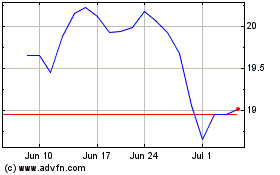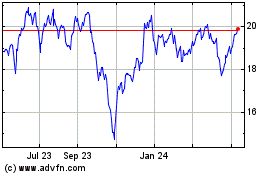Real Estate Executives Receive Record Pay In 2011
May 29 2012 - 6:16PM
Dow Jones News
Compensation for executives at public real estate companies grew
faster than the stock performance of their companies last year,
leading some shareholders and proxy governance firms to complain
about excessive pay packages.
A new study by FPL Associates, a Chicago compensation
consultancy, found that the median total compensation for top
executives at the 100 largest real estate companies increased 14%
in 2011 from the prior year to $8.65 million. That was the highest
level of compensation since the study's inception a decade ago and
nearly double the average gains of real-estate company stocks. FPL
includes as compensation an executive's base salary, bonus and the
value of long-term incentive awards at the time granted.
For example, the median return of the 100 real estate companies
tracked by FPL was roughly 6%, below the growth in average
compensation.
The FPL study, which pulled compensation data from federal
filings, found that much of the rise in total compensation came
from bonuses and lucrative long-term incentive awards, which on
average increased 24% to a median of $4.65 million. The study
looked at the pay packages of chief executives, chief operating
officers, chief financial officers and general counsels.
Executive base salaries, which held relatively flat between 2008
and 2010, increased 10% last year. That was the largest salary
increase on a year-over-year basis since FPL started the study in
2002 and contrasts to that of executive salaries in most other
industries which have remained flat for years.
"It was a great year for [real estate] executives from a
compensation perspective," said FPL Senior Managing Director Jeremy
Banoff. He noted that many boards wanted to reward executives for
good results, even though some gave rewards that outmatched
returns.
The highest-paid executive in the FPL survey is Michael Farrell,
chief executive of Annaly Capital Management Inc. (NLY), a New
York-based REIT that invests in mortgage securities and manages a
portfolio worth more than $100 billion. Farrell received a
compensation package worth $35 million, of which $32 million was a
cash bonus, according to FPL. That was up 48% from 2010 and far
exceeded the 7% return to shareholders over the past 12 months, as
of Friday's close.
Annaly didn't return calls seeking comment. But Daniel Furtado,
an analyst at Jefferies & Co., said investors so far don't seem
perturbed about Farrell's pay package in part because the company's
overall expenses, including compensation, are relatively low.
"Michael Farrell and the Annaly management team is the envy of the
REIT space," Furtado said.
David Simon, the chief executive of Simon Property Group Inc.
(SPG), the nation's largest shopping mall landlord, was the
second-highest-compensated real estate executive in the study.
Simon was awarded a compensation package valued at roughly $32
million in 2011, up 159% from 2010. (The CEO actually was given
retention stock awards worth $120 million in 2011 but paid out over
eight years. FPL included just one-eighth of the value of the award
when calculating 2011 compensation.)
Simon and his company were put on the defensive last week after
shareholders, in a nonbinding vote, rejected the CEO's eight-year
contract, which in addition to the retention award includes $12
million a year in performance-based stock awards.
Glass Lewis & Co., a proxy governance firm, advised
investors to reject the Simon plan partly because they questioned
the validity of giving Simon--whose father and uncle founded the
company 52 years ago--such a large retention package. The proxy
governance firm also was troubled that Simon would benefit from
those awards regardless of the company's performance and even if he
departed before his eight-year contract expired.
But Simon Property defended its CEO's pay package. "David
Simon's leadership of SPG has produced an increase in shareholders'
equity of over $40 billion and cumulative shareholder returns of
597% over the last 10 years," a company spokeswoman said. "This
outstanding performance places SPG as the 6th best performing
company in the S&P 500 while Mr. Simon was the 6th lowest paid
CEO in the S&P 500 for the same period."
Lukas Hartwich, an analyst at Green Street Advisors, said that
while Simon Property has posted strong performance over the past
few years, the compensation package was too large based on the size
and performance of the company and shouldn't be used as a blueprint
for the industry. "We hope it doesn't set a precedent," he
said.
Shareholders also gave a nonbinding no vote two weeks ago to the
compensation package of John Kilroy, CEO of Kilroy Realty Corp.
(KRC), whose compensation was valued around $18 million, according
to FPL. It was the second year in a row that Kilroy's executive
compensation failed to pass shareholder muster.
Analysts and investors long have argued that Kilroy's executive
pay packages are too generous considering the company's size.
Kiloy's market capitalization, at $3 billion, is one-twentieth the
size of Simon Property's.
"It's a large dollar amount," Hartwich, of Green Street
Advisors, said, adding that he believes Kilroy's executives are
overpaid considering the company's market capitalization.
He noted that excessive compensation has a bigger impact on
smaller companies because executives take home a greater proportion
of profits.
A Kilroy spokesman declined to comment.
-By A.D. Pruitt, Dow Jones Newswires; 212-416-2197;
angela.pruitt@dowjones.com
Annaly Capital Management (NYSE:NLY)
Historical Stock Chart
From Mar 2024 to Apr 2024

Annaly Capital Management (NYSE:NLY)
Historical Stock Chart
From Apr 2023 to Apr 2024
